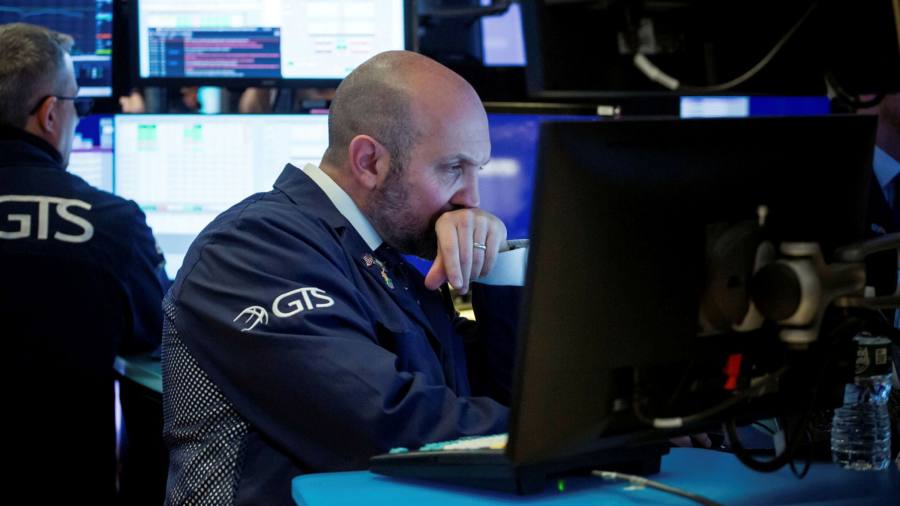[ad_1]
This time last year, markets were in the grip of the coronavirus crisis. Stock markets were tanking and central banks were embarking on aggressive interest rate cuts and other stimulus measures to steady the financial system. It all sent bond prices rocketing, pushing yields to rock-bottom levels.
Now, the issue for investors is that those bond prices have been falling back and yields are rising. Some hedge funds are raking in big returns. But other institutional investors are fretting that it could yet seriously destabilise markets.
What is going on?
In short: inflation. Serious consumer price rises themselves are not here yet — the global economy is still only tentatively creeping out of its coronavirus hibernation. But investors have good reason to think it could start to bite.
Commodity prices have already shot higher in anticipation of a global economic recovery. Copper has hit its highest price point in a decade. Oil is back above $60 per barrel, having wiped out the coronavirus shock. Companies in the US and elsewhere are reporting shortages of goods and rising costs for raw materials. It all looks like a recipe for consumer price rises.
Central to all this, the US is set to embark on a huge fiscal stimulus package worth around 10 per cent of gross domestic product. The UK government too is continuing to spend its way out of the crisis, as chancellor Rishi Sunak made clear in the Budget. It’s hard to see how this can fail to stoke demand and, by extension, inflation.Â
What does this mean for my bond holdings?
It’s bad news. By any sensible historical measure, bond prices are still sky high, thanks to the vast monetary stimulus launched by central banks seeking to soften the blow of the pandemic. But the pullback at the start of 2021 has been fierce as investors try to price in inflation before it happens. It is the worst start to a year in bonds since 2015.
Inflation is the mortal enemy of the bond market for two reasons. It eats away at the real value of the fixed-interest payments. And it could force the hand of inflation-targeting central bankers into limiting their stimulus. The US Federal Reserve, the most influential central bank, has been at pains to stress it is happy to let inflation run hot before it taps on the brakes. But the market is testing its resolve. And Fed chairman Jay Powell made it clear this week that he is not yet alarmed at the bond market shake-out.
When bond prices fall, yields rise. In the US, 10-year yields have pierced 1.5 per cent for the first time since the pandemic struck, with a particularly wild day’s trading on February 25.Â
The UK, which not so long ago was flirting with cutting interest rates below zero, has seen a rapid rise in yields to around 0.8 per cent. On top of this, the Budget revealed government plans to borrow even more than banks had previously expected.
HSBC believes the UK government bond market is exaggerating the risk of a rise in interest rates from the Bank of England, but it warns clients to buckle up for a “choppy ride†in gilts.
Does it matter for my assets?
Yes. One key reason why stock markets have been flying high in recent months, despite the economic impact of coronavirus, is precisely that bond yields are so low.
That has flattered listed companies’ future cash flows and made equities simply a more alluring bet. Aside from big institutions that are obliged to hold a certain proportion of bonds for regulatory reasons, many fund managers shy away from assets that offer such slender returns and are so pricey, particularly with the risk that they might fail to keep pace with inflation.
But the danger is that with yields picking up, some parts of the stock market might suffer. We have seen this already, particularly with red-hot technology stocks. The tech-heavy Nasdaq Composite index has dropped more than 8 per cent since mid-February, for instance. But it is better news for markets that are less dependent on tech, and more focused on financial stocks and energy companies. The FTSE 100, which falls squarely in that camp, is a more modest 2.5 per cent lower over the same period.
The main thing to watch out for is an acceleration in the yield pick-up we have seen so far. At this stage, the bond wobble is just that: a wobble. Any disorderly repeat of the February 25 unravelling would be particularly alarming.
What does this mean for my portfolio mix?
The classic split for an investment portfolio is 60 per cent equities, 40 per cent bonds. The premise is that as one asset class falls, the other usually rises. But this orthodoxy has been looking shaky for years, as yields have sunk so low that they offer little scope for further gains if stocks take a knock.
This recent pick-up in yields provides a little more padding.Â
If you believe, as many do, that central banks will step up to prevent bonds falling too far, too fast, then bonds should continue to offer a little comfort in the event of a rapid descent in stocks.
What about other inflation hedges such as gold?Â
Gold is a bit of an unreliable friend to investors. On paper, it should be rallying in anticipation of higher inflation. Instead, it has hit an eight-month low. Gold does not pay out any returns to holders. Those higher debt yields now make bonds a more attractive bet.
[ad_2]
Source link





